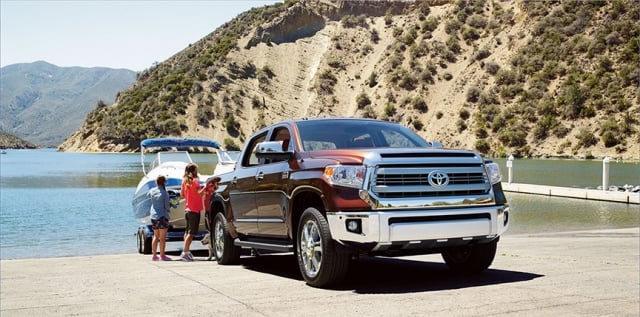If you have been following the ½ ton truck market, diesel is the latest buzz word. Ram’s new EcoDiesel V6 option in their 1500 has been extremely well received. In fact, they have pre-sold all 8,000 initial units they allocated in three days. Many of the buyers paid cash without ever driving one. Demand is certainly there for these trucks.
Shortly, Nissan will be selling their new Titan with a 5.0 V8 diesel built by Cummins. Ford is rumored to be prototyping a diesel for a future F-150. GM is, also, poised to enter the market place with a small displacement V6.

This is Toyota’s concept vehicle shown at the 2007 SEMA Show. Photo courtesy of Tundraheadquarters.com
Wards Auto recently broke the news that the 2016 Toyota Tundra is a diesel. The news is a little shocking that they will be using a version of the same 5.0L V8 Cummins that Nissan announced just a few months ago. That being said, Toyota has been very strategic with its movements in the truck market. Just a few years ago, Toyota opted to build its new Tundra in Texas. One major consideration for that move was that Texas is the heartland of trucks, and by building it in Texas, no one can say it isn’t an American-built truck. So, opting to use a Cummins engine instead of the Hino that Toyota had previously displayed at various shows should come as no surprise. In the diesel market place, Cummins represents quality, durability, and in the aftermarket, power.
 The rumor has it that the Tundra will be sporting somewhere north of 300 horsepower, which seems very logical considering Cummins offers the 5.0 V8 in its medium duty trucks with up to 275 horsepower and 560 pound-feet of torque. It is easy to see how with a few tweaks they could yield another 25 or even 50 horsepower out of it. No word yet if they are getting that through increased rpm, boost or other refinements.
The rumor has it that the Tundra will be sporting somewhere north of 300 horsepower, which seems very logical considering Cummins offers the 5.0 V8 in its medium duty trucks with up to 275 horsepower and 560 pound-feet of torque. It is easy to see how with a few tweaks they could yield another 25 or even 50 horsepower out of it. No word yet if they are getting that through increased rpm, boost or other refinements.
One major driving force behind this recent trend is the government’s new CAFE regulations. In 2016, the average is being bumped up to 35.5 mpg. If Ram’s new EcoDiesel is an indication of how the others will perform, we will have ½-ton pickup trucks getting high 20s to low 30 mpg. This will certainly help raise the manufacturers average fuel economy ratings.


















